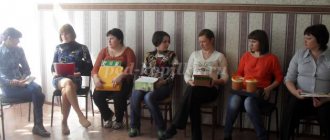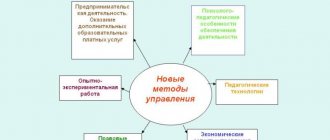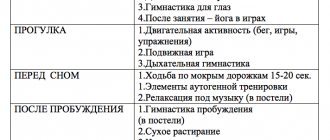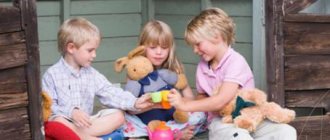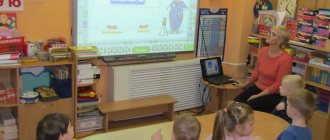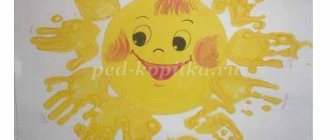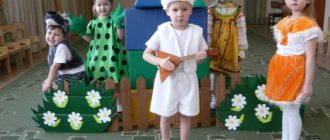Master class for preschool teachers. Educational technology "Children's Council"
Master class for kindergarten teachers “Educational technology “Children’s Council” as a condition for the individualization of children.”
Author: Irina Vyacheslavovna Makarova, teacher of MBDOU No. 23 “Golden Cockerel”. This master class will be useful for preschool teachers, students of pedagogical faculties, and parents. Goal: to search for new forms of work and ways to use the “children’s council” technology in a preschool organization in the conditions of the Federal State Educational Institution. Plan of the master class: 1. Introductory speech; 2. Practical game exercises; 3. Summing up, exchange of opinions. Number of participants: up to 10 people. Duration: up to 20 minutes. Progress of the master class: Today, in connection with the introduction of the Federal State Educational Standard in preschool education, each of us, a teacher standing at the origins of childhood, needs to clearly understand that in our hands is the most valuable thing in a person’s life - a child.
One of the main components of a teacher’s pedagogical competence, in my opinion, is respect and recognition of the student’s personality and support for children’s uniqueness. The future development of a preschool child depends on how much we adults are guided by this. The educational technology “Children's Council” is designed to help teachers with this. Dear colleagues, how many of you are familiar with and work with this technology? I think you will agree with me that the children's council is the place and time for business and spiritual communication between adults and children, which sets the meaning of the entire life of the group. The purpose of the children's council is to unite children and adults around events, joint affairs, and actions. The Children's Council does not have a specific structure. For ourselves, we have identified some semantic parts: greetings, communication games, news exchange, philosophizing. In a joint dialogue, we discuss thoughts, ideas and plans, draw up an activity plan, determine who will do what, and in accordance with the choice, the children are distributed among activity centers. This form of interaction presupposes the active participation of children in discussing problems and making decisions, organizing educational activities based on the free, conscious and responsible choice by children of the content of their education. So, the Children's Council involves a general meeting of a group of children together with teachers. Everyone gets the opportunity to talk about events in their lives, describe their experiences, share desires, and receive new information from others. At the initiative of children and adults, upcoming classes are planned, group rules are established, and various games and exercises are conducted. I invite colleagues to participate in the master class and propose to unite in two groups. In order to understand what children's advice is, it is necessary to determine for yourself an understanding of this form of interaction. I present to your attention the following exercises: “CONTINUE THE SENTENCE” For the first group of participants: •Children’s council is…. (your answer options). For the second group of participants: •Children's council does not... Time to complete the task is 3 minutes. And I will ask you, dear audience, to answer the following question: “A MODERN PRESCHOOL CHILD, WHAT IS HE WHAT IS HE? WHAT QUALITIES DOES HE HAVE? •curious, interested, actively exploring the world; •capable of organizing their own activities; •benevolent, able to listen and hear his partner, respecting his own and others’ opinions; •ready to act independently and be responsible for their actions. Thus, we have a portrait of a modern preschooler. Now let's go back to our groups and listen to what they did. Children's advice is...
-choice; -participation; -complicity; -news; -initiative; -cooperation; -discussion; -interaction; -life creativity; -communication; -assistance; -planning; -activity; -communication; -Union.
Children's advice is not...
-class;
-educational activities; -has regulations; -has uniform rules; - obligatory participation; -compulsion; -has structures; - educational and training activities; - single share. Despite all the apparent simplicity of holding a children's council, I want to say that problematic situations often arise and they cannot always be resolved quickly and masterfully. I suggest that my colleagues do this now. “WHAT TO DO IF...” We work in groups. Task for the first group: 1. If the child chooses nothing during joint planning. What should I do? Task for the second group: 2. If the child chooses the same center. What should I do? Work schedule: 3 minutes. While the groups are preparing, let's talk some more about it. Please come up with a proposal using the abbreviation GEF. Our version: The philosophy of genius is the basis of meaning. Let's return to the tasks of our groups and listen to their answers. 1. If the child chooses nothing during joint planning. What should I do? •After most of the children have made their choice, repeat again to the remaining children what materials are available in the activity centers, name possible actions if necessary, wait a minute and repeat their decision. •Invite a child who is at a loss to choose to join your work. •Offer him (if the child is psychologically ready to cooperate with you) a game of scouts (aliens, journalists), during which he will have to go around all the centers of activity and tell you about what interesting things the children are doing. It is important here not to give in to negative statements (they don’t do anything, they play around). Keep your child in this role for several days: “And there is a special task for you - you will again be like a scout,” and perhaps soon you will notice his desire to make his own choice. 2. If the child chooses the same center. What should I do? •If a child is enthusiastic, do not disturb him. •If it is necessary to change a sedentary state, offer to move around and carry out an important task. •If there is no dynamics in the child’s actions, offer variety with additions that are attractive to the child. •“Close” the center for a while, citing a ban. I suggest you answer the question: DO YOU SEE PARENTS PARTICIPATING IN THE CHILDREN'S COUNCIL? IF SO, WHAT IS THEIR ROLE? For both groups. While the groups are preparing, I propose to perform a practical task for the audience. Express your attitude towards the children's advice, if your attitude towards this technology is positive, then put the pebble in a jar with a cheerful smiley face, if your attitude is neutral or dubious, then put it in a jar with a sad smiley face. After the participants' responses, I will summarize. A parent is an active, voluntary, equal participant. Interaction with parents in the children's council: •We invite you at a time convenient for parents. •We wonder if our help is needed. •We create instructions for parents about what and how to do in activity centers. •We encourage parents, but do not ask unnecessary questions and do not interfere. •We openly and sincerely thank them and involve them in discussing the lives of children in the group. I want to thank my colleagues for their work in the master class and give them booklets. Reflection. The result with jars. Whether or not to use this form of interaction with children is up to you, dear colleagues! But I would like the Children's Council to take place. Because... •Knowledge of one’s rights and responsibilities, the ability to freely express one’s opinion is one of the indicators of a socially developed personality. •The participation of every child in decisions affecting his interests is of particular importance for achieving social justice and social inclusion, for equality of opportunity. •The child's right to be heard and taken seriously is one of the basic values of life. I would like to draw attention to the last phrase: The child’s right to be heard and taken seriously is one of the basic values of life. At the end of our meeting, I want to tell a parable. A long time ago, in an ancient city there lived a Master, surrounded by disciples. The most capable of them once thought: “Is there a question that our Master could not answer? “He went to a flowering meadow, caught the most beautiful butterfly and hid it between his palms. The butterfly clung to his hands with its paws, and the student was ticklish. Smiling, he approached the Master and asked: “Tell me, what kind of butterfly is in my hands: alive or dead?” He held the butterfly tightly in his closed palms and was ready at any moment to squeeze them for the sake of his truth. Without looking at the student’s hands, the Master answered: “Everything is in your hands.” Our skill, dear colleagues, determines how a child will emerge from kindergarten: and I believe that he will be a creative, inquisitive, thoughtful person, ready to consciously make choices and be responsible for them. All in our hands! Thank you for your attention and cooperation!
We recommend watching:
Development of communication skills of children 5-7 years old in theatrical activities Spiritual and moral education of preschool children Introducing preschool children 5-7 years old to Russian folk culture Lesson notes for preschoolers. Memorizing Serov's poem "Snowdrop"
Similar articles:
Methods of conducting physical education classes in kindergarten
Morning exercises in the preparatory group in a playful way
Teasing games for children 5-6 years old
Dance festival in kindergarten for children 5-7 years old. Scenario
Outdoor games as a means of harmonious development of a child
Master class “Types of methodological products” (methodological recommendations for organization and conduct)
Municipal autonomous preschool educational institution kindergarten No. 63 “Crane” of a combined type, Kiselevsky urban district, Kemerovo region Methodological recommendations
for organizing and conducting a master class “Types of methodological products”
Author:
Savelyeva Olga Vladimirovna,
deputy head for methodological work, highest qualification category Kiselevsk, 2011
Explanatory note Presented material:
·Text document “Master class “Types of methodological products”
List of sources used:
·Gin A.A.
Lesson traditions //Internet magazine “Eidos”. - 2000. - February 21. https://www.eidos.ru/journal/2000/0221-01.htm. — In nazag: Center for Distance Education “Eidos”, e-mail · GOST R 7.0.4-2006 “Publications. Imprint" · Pokrovskaya M.B. Directory of the publisher and author: Editorial and publishing design of the publication [Text] / M.B. Pokrovskaya // Library life of the Belgorod region: collection. Issue 1 (27). – Belgorod, 2005. – P.49-62 Comments on the possibilities of using and effectiveness of this material:
The proposed master class “Types of methodological products” is one of a series of master classes within the framework of the “School of a Young Teacher”.
Its goal is
to increase the competence of teachers in the field of educational and methodological support of the educational program.
The variability and mobility
of the proposed material is obvious.
The content of this master class is designed for young teachers. But it was successfully carried out both with young methodologists and with experienced teachers. In addition, any methodologist, head of a structural unit or trainee teacher can use this material to organize work with teachers. The strength of this development
is the proposed methodological comments and explanations for the stages of work.
They allow you to better understand the content of the master class and the specific work during it; · make it possible to vary the content of the stages depending on the characteristics of a specific group of teachers and the available teaching materials for demonstration; · save time during preparation; ·reduce the labor costs of the methodologist to achieve learning effectiveness. This master class is effective.
It was held: ·as part of a city workshop for managers and deputies. heads of additional education institutions “Software and methodological support for the educational process of UDO”, Kiselevsk, 2007 (52 people were present); · within the framework of the regional seminar for methodologists of additional education institutions “Forms of methodological work with the teaching staff” (work experience no more than 5 years), Kemerovo, 2008 (38 people attended); · within the framework of the regional competition “The best methodologist of a multidisciplinary institution of additional education” - III place, 2009 (attended: 32 people) In addition, this methodological material was awarded a diploma of the II degree laureate of the regional competition of methodological materials (2010) and published on the pages of the magazine “School Principal” No. 11, 2011
From the reviews of colleagues: “The master class is dynamic, information-rich and practical. Rational in the use of teaching methods and means. The content of the information is scientific and easy to understand.” According to the results
reflections (122 people) · “The master class material is useful.
I will use it in my activities" - 97.3% of participants ·"The information is useful. It takes time to comprehend” - 2.7% of participants (young teachers) Master class
Topic:
Types of methodological products.
Target:
to increase the competence of teachers in the field of educational and methodological support of the educational program
. Objectives:
To specify the concept of teaching materials.
Show the similarities and differences between the educational and methodological package and the educational and methodological complex. Introduce the classification of teaching materials and its components. To develop the ability to plan the content of teaching materials (a separate lesson, section of the educational program). Venue:
MADOU kindergarten No. 63 “Crane” of a combined type and MOU DOD “Center for the Development of Creativity of Children and Youth”
Equipment:
multimedia projector, laptop, tables and chairs according to the number of people invited to the master class, sheets of white paper (20-30 pcs.), ballpoint pens (10 pcs.), Whatman paper for reflection, markers (5-6 pcs.)
Video sequence:
presentation in the Microsoft Power Point program, methodological exhibition “Types of methodological products”, educational and methodological kits and educational and methodological complexes of experienced teachers of the institution
List of sources used:
·Gin A.A. Lesson traditions // Internet magazine “Eidos”. - 2000. - February 21. https://www.eidos.ru/journal/2000/0221-01.htm. — In nazag: Center for Distance Education “Eidos”, e-mail: [email protected] · GOST R 7.0.4-2006 “Publications.
Imprint" · Pokrovskaya M.B. Directory of the publisher and author: Editorial and publishing design of the publication [Text] / M.B. Pokrovskaya // Library life of the Belgorod region: collection. Issue 1 (27). – Belgorod, 2005. – P.49-62 Hod:
Hello, dear colleagues!
I am glad to welcome you to our master class dedicated to the three mysterious letters of the UMK (SLIDE). First, together we will remember the last review-competition of classrooms and conduct a brief analysis of it. Then we’ll try to answer the question “What is teaching and learning?” (Methodological comment: The topic of the master class is presented in question form
).
Then we’ll train our brains and classify the teaching materials. And finally, let’s pull out something valuable from the recesses of memory - we’ll compile the contents of individual teaching aids. You all know that during the autumn holidays, a review competition of classrooms was held at the preschool educational institution and the Center according to the following criteria (SLIDE). Particular attention in this review-competition was paid to the methodological equipment of classrooms, or more precisely, to identifying the experience of teachers in the formation of teaching materials for educational programs. From the materials presented by the teachers it is clear that work is being done, but there is some misunderstanding about what the teaching materials and its contents are. Let's try to figure it out. (SLIDE) The abbreviation UMK stands for educational and methodological... But here another question arises: K - complex or set? (teachers express their opinions) (
Methodological comment:
when answering, the methodologist needs to get the teachers to justify their statement. As a rule, the group is divided into two “camps”, depending on the expressed point of view on the question asked. The methodologist must adhere to a neutral point of view , to maintain the intrigue until the end of the master class )
Opinions are divided... I propose to return to this issue at the end of the master class.
(SLIDE) Any KM has several so-called levels (Methodological explanation: For a better understanding, it is necessary to demonstrate the levels of KM using the example of the folder “KM for the educational program” of one of the experienced teachers of the highest qualification category
) 1st level - KM of a particular lesson.
Level 2 – teaching materials for the section of the educational program. Level 3 – teaching materials of the educational program. What is included in the educational complex?.. ( teachers' answers)
Everyone sitting here gave open classes.
Remember and name the methodological products that you prepared for these classes (Answers: notes or lesson script, visual material, cards for students, creative tasks, cards...).
Everything you listed constitutes the teaching materials of a separate lesson.
But it should be noted that not all of these methodological products must be developed for each lesson! It is necessary to differentiate the content of the teaching materials of a lesson depending on its goals, the composition of the group of students, the available capabilities (technical, intellectual, resource, etc.) The teaching materials for a section of the educational program consists of teaching materials of individual classes for this section (show)
.
And accordingly, the teaching materials of the educational program make up the teaching materials for the sections of the program (show).
Of course, you understand that such a volume of work cannot be completed efficiently in a short time.
Such work is carried out throughout the entire pedagogical activity: groups of students, time requirements, technical means, etc. change. You have been shown the experience of designing a teaching aid that you should strive for. Daily conscientious preparation for the lesson, your interest in developing new methodological ideas will gradually help you assemble your own unique teaching materials for the program. The levels of teaching materials are now clear. But the question arises, what methodological products can constitute the teaching materials of a lesson or section? (Methodological explanation: Option 1. The methodologist listens to and specifies the answers. After the discussion, the methodologist, based on the content of the slides, talks about the components of teaching materials and shows the best materials from the experience of the institution’s teachers, thereby presenting them. It is better to arrange the materials in the form of an exhibition at a special exhibition stand (stand) Option 2: The group is divided into several subgroups (optional) and materials are sorted in accordance with the proposed classification. Option 3: The group is divided into 7 subgroups. Representatives of the groups receive tokens on which groups of teaching materials according to the proposed classification are written. Each the subgroup receives the task: to choose from the proposed materials only those that belong to the group specified in the token, for example, “Program and methodological materials". 5-7 minutes are given to complete the task. Then each group presents its materials and gives reasons for its choice. For The presentation is given 2-3 minutes. If there is a need to discuss the group’s opinion, the methodologist leads the debate and ends it by showing a slide on which the list of materials being discussed is indicated.
) Allow me to present a classification of methodological products that can make up teaching materials: 1. (SLIDE) Program materials.
This includes... (educational program and thematic planning, KTP) 2. Practical materials. Which? · collections (tasks, exercises, test materials, laboratory work, etc.); ·workbooks for students; · Readers. 3. Theoretical materials: · information material (newspaper, magazine articles, information from Internet sites, etc.); ·lecture course; ·tutorial; ·thematic selection (poems for the holiday, games, dynamic breaks, etc.). 4. The most famous methodological products are visual materials: tables; ·scheme; ·atlases; ·albums; · audio and video materials; ·graphs; posters; ·diagrams; ·leaflets; · didactic materials (cards, punched cards, etc.); ·newsletter; ·newspaper; · educational visual aid; 5. Reference materials: · dictionaries of terms; · encyclopedias; additional information on the topic; 6. Bibliographic materials: · card index · annotated index; ·catalog; 7. And directly teaching materials: · teaching aids; ·guidelines; ·methodological developments (lesson scenarios); ·methodological notes; reminders; · provisions. In addition to teaching materials, you can create thematic folders during your work. For example, by type of activity, as was done by arts and crafts teacher N.A. Maksimova. (SHOW), or to a separately created collection of costumes, like that of the head of the children's exemplary group of the fashion theater T.V. Maksimova. I propose to compile an approximate list of methodological products of the educational complex. To do this, we will divide into teams: “Young teacher” (work experience 0-4 years) “Master teacher” (work experience 5-10 years) “Professional teacher” (work experience 11-20 years) (Methodological explanations: Groups are larger 6-7 people can be divided into subgroups to improve comfort during work. Each group is given specific material (lesson notes, a section of a familiar educational program is determined, etc.). The time of work, the time of presentation of results must be specified)
Time of work on task for 10 minutes.
To present the results of the group’s work – 1 – 2 minutes. Be creative when presenting your work! (Methodological explanations: Groups complete the task. At the end of the work, a presentation takes place.
) Each type of methodological product can become a multimedia product - translated into an electronic version for ease of use in the classroom.
We will talk about this at the next master class “Technology for developing a multimedia product.” The work was fruitful and “hot.” But the time has come to return to the mysterious letter K in the abbreviation UMK. What does it mean: a complex or a set (Methodological explanation: the teachers’ answers are listened to. Further conversation is conducted with a demonstration of real sets and complexes of various methodological products
)
The set is
the same information carrier - electronic (set of disks);
· printed (set of printed materials); audio kit; ·video set; ·a set of photographic materials, etc. Complex
- 2 or more information carriers, the material on them is different, but complementary (
For example,
a CD with information and educational visual materials and a notebook for students).
I suggest checking whether you can distinguish an educational and methodological complex from an educational and methodological set. Game “YES - NO” Assignment: I show you a set of objects, methodological products and ask the question: “Is this a set?” If you agree that there is a set in front of you, answer “Yes”; if you do not agree, answer “No”. Let's try (Methodological comment: It is necessary to “rehearse” the game 2-3 times, and then play
).
(Methodological explanation: For the game, you can use 6-7 sets of objects (discs, books, audio cassettes, postcards, etc.) or methodological products. This will add some variety to the game and help the methodologist understand whether teachers consciously make their choice between “ set" and "complex"
) Once again I draw your attention to the fact that the teaching materials of a separate lesson or even section should not necessarily include all of the listed methodological products, but only those that help the teacher to most fully reveal the material, the student - with his interest assimilate.
The quality of education depends on this. It is gratifying to see that every teacher has teaching materials for open classes; young teachers have already formed teaching materials for individual sections of the program and are actively replenished by teachers with experience in teaching. A lot of work is being done and has its own perspective - teaching materials for each educational program implemented in our Center. To summarize, I would like to say a big thank you to everyone for their active work. See you again at the master class “Technology for developing a multimedia product.” When leaving the audience, leave your autograph on a piece of Whatman paper in one of the columns: “The master class material is useful. I will use it in my activities”, “The information is useful. It takes time to understand”, “Nothing new or useful has been heard” (Methodological explanation: You can announce the time and place of the next master class and offer to fill out a questionnaire. The results of the questionnaire will help the methodologist better prepare and conduct the upcoming master class) QUESTIONNAIRE Purpose: identify the reasons for insufficient use of media in classes. Select one or more answers that are acceptable to you to the question: Why do you not use (or rarely use) multimedia teaching aids in your teaching practice?
·
I feel insecure when using technology and programs.
·
I am afraid of technical breakdowns that disrupt the course of the lesson.
·
The use of media in the classroom involves very high costs.
·
I do not have methodological training for using media.
·
I am very unfamiliar with the resources available.
·
I consider the effectiveness of media classes to be insignificant.
·
Other reasons (specify) _____________________________________ Appendix 1.
Methodological recommendations
for organizing preliminary work
1. Talk or conduct a preliminary survey. The purpose of this work: to identify the category of teaching staff participating in the master class, their age, length of teaching experience, and determine the level of knowledge on the topic. 2. Prepare the necessary theoretical information (based on survey data or questionnaire analysis). 3.Develop practical tasks. 4.Create and write a script for the master class. 5.Develop a multimedia presentation in Microsoft Power Point. 6.Prepare a table for reflection. 7.Select musical accompaniment for practical work. 8.Immediately before the master class, prepare multimedia equipment and the audience: place tables and around them a number of chairs equal to the number of participants, lay out sheets of white paper, pens for work, secure the “Reflection Sheet”, place markers nearby. If the master class is held for teaching staff of your educational institution (i.e. the audience is familiar to the presenter), then step 1 can be skipped during preparation or replaced with a review-competition of teaching materials, classrooms, etc.
